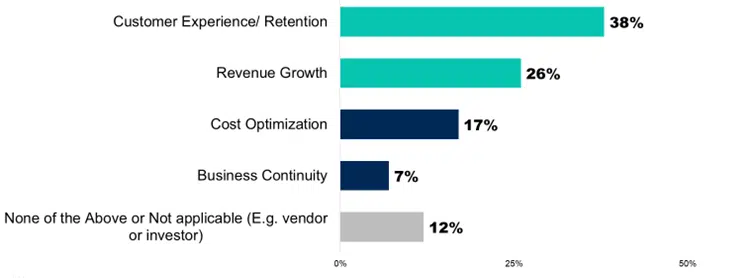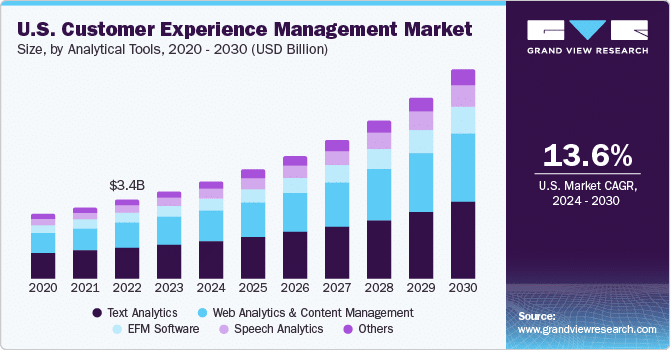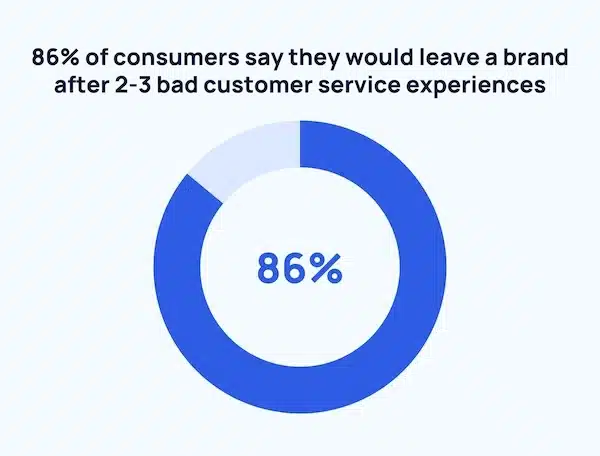In 2025, the latest customer experience statistics reveal crucial insights into how consumers interact with businesses, shaping their satisfaction and loyalty.
As customer expectations continue to evolve, businesses must adapt to stay competitive and foster lasting relationships.
E-commerce sites worldwide quickly realize that a great customer experience is where the money is. Poor customer service hurts a customer’s experience, as evidenced by 89% of eCommerce consumers.
They quickly stopped buying at stores that offered poor customer service. Since it costs six to seven times more to attract a new customer than to retain an old one, improving customer experience is all the more critical.
Check out these latest customer experience statistics that show the importance of providing a great customer experience.
Key Statistics on Customer Experience
1. Generative AI in customer service: A game-changer for 2025 and beyond
As customer expectations rise and support teams face growing demand, generative AI is rapidly transforming how businesses deliver customer experience (CX). According to Gartner, by 2025, 80% of customer service and support organizations will adopt generative AI technologies to enhance agent productivity and streamline interactions.
Generative AI—tools that use large language models to create content, automate responses, and support live agents—is currently at the “Peak of Inflated Expectations” in Gartner’s Hype Cycle, which means it’s getting a lot of attention and hype. However, most companies are still figuring out how to use it effectively.
Many expect it to solve significant problems, such as improving customer service or reducing costs, but not all results have been proven yet. Still, early signs indicate real potential, with 38% of business leaders stating that their primary goal with generative AI is to enhance customer experience and retention.

2. Growth of the global customer experience management market
The global customer experience management (CEM) market was valued at approximately $12.04 billion in 2023. It is expected to expand rapidly, with an average annual growth rate of 15.8% from 2024 to 2030. (Source)

This growth is driven by the increasing focus on improving customer satisfaction, retention, and overall experience across various industries.
3. Consumers are willing to pay more for a great experience
A significant 61% of consumers are ready to spend at least 5% extra if they know they’ll receive a good customer experience. (Source)
This shows how much customers value being treated well and having their needs met. Businesses that cater to their needs will naturally gain an edge over competitors, as customers are not only willing to pay more but are also likely to return and spread the word about their positive customer service experience.
They’ll be equally quick and eager to spread the word about poor customer experience, so make sure your service only results in satisfied customers and positive customer experiences throughout the customer journey.
4. 80% of companies plan to invest more in customer experience
A significant 80% of companies plan to increase their investment in customer experience (CX). (Source)
This means that most businesses now recognize the importance of providing excellent service and are willing to put more resources into ensuring their customers have positive interactions.
Customer Experience Statistics Related to Customer Loyalty and Retention
5. Almost all consumers and managers agree: customer service drives brand loyalty
As many as 97% of consumers and 98% of contact center managers believe that the quality of customer service interactions plays a significant role in shaping brand loyalty. (Source)
This means that nearly everyone, whether they’re on the buying or managing side, agrees that how a company handles customer service can make or break its relationship with customers.
6. 86% of consumers would abandon a brand after just two lousy service experiences
If a customer has two negative experiences with a brand, there’s an 86% chance they won’t return. (Source)

This shows how important it is for businesses to provide a stellar and positive customer experience consistently. Even a few mistakes and not being up to mark as per customer expectations can result in losing a loyal customer forever.
7. A 5% boost in customer retention can drive a 25% profit increase
Improving customer retention by just 5% can lead to a significant 25% increase in profitability. This shows how important it is to keep your customers happy and returning. (Source)
When customers remain loyal, they continue to purchase from your business, often increasing their spending over time. This reduces the costs of acquiring new customers and increases overall profits.
8. Customer service impact: 93% more likely to return
When a brand delivers excellent customer service, 93% of consumers are more likely to make repeat purchases. (Source)
This is a win-win situation for brands. Clearly, great service helps resolve issues and builds loyalty and trust, encouraging customers to return and continue buying from that brand.
9. 80% of consumers prefer brands that offer personalized experiences
80% of consumers are more likely to buy from brands that offer personalized experiences, which is increasingly important in fostering loyalty. (Source)
Consumers today want more than just products or services—they want experiences tailored to their preferences. This personalization can be as simple as product recommendations based on past purchases or as complex as customized marketing messages that truly resonate with them.
Technology and Customer Experience
10. Nearly half of customer service professionals aim to boost efficiency with AI and automation
Nearly 45% of customer service professionals plan to enhance their operations by integrating more AI and automation tools, which are expected to streamline processes and improve service delivery. (Source)
Businesses are turning to these technologies to make customer service smoother and prompt. Integrating AI and automation helps them handle tasks faster, reduce human error, and provide quicker, more accurate responses to standard customer inquiries.
11. Customers connect through multiple channels, primarily online
On average, customers interact with brands through nine different channels or touchpoints. These include social media, websites, emails, and even in-store visits.
Moreover, approximately 60% of these interactions occur online, highlighting the importance of adopting an online omnichannel marketing approach for businesses. (Source)
Financial Impact of Great Customer Experience
12. Customer-centric businesses see double the revenue growth
Businesses prioritizing customer experience see nearly double the revenue growth compared to those not adopting a customer-first approach. (Source)
This demonstrates a clear connection between prioritizing customers and generating more revenue. When companies prioritize customer satisfaction, it often leads to happier customers, more repeat business, and higher revenue. On the other hand, businesses that neglect customer experience may struggle to keep up with more customer-focused competitors.
13. Superior customer experience drives 5.7x more revenue than competitors
Brands that offer a better customer experience earn significantly more—about 5.7 times more—than those that don’t focus on it. (Source)
This again shows that when companies try to keep their customers happy by providing excellent service, easy interactions, and a smooth overall experience, they see much higher profits. On the other hand, businesses that don’t prioritize customer experience miss out on this extra revenue.
14. 73% of companies with superior customer experience outperform their competitors financially
When companies provide a better-than-average customer experience, they are more likely to outperform their competitors financially. 73% of these companies do better financially than those that focus less on customer satisfaction. (Source)
When your customers have a positive experience, they’re more likely to remain loyal, spend more, and even recommend the company to others, ultimately contributing to improved financial performance.
Cost Savings and Efficiency
15. The cost of poor customer service: $1.6 trillion lost by U.S. companies
When customers experience poor service, they often take their business elsewhere. And this isn’t just a minor inconvenience—it’s a significant financial loss.
In the U.S. alone, companies lose a staggering $1.6 trillion due to customers switching to competitors due to unsatisfactory service. (Source)
This suggests that if a company fails to prioritize customer satisfaction or neglects it entirely, it can have a significant impact on its bottom line.
16. You can lower support costs by reducing customer inquiries
When you streamline customer interactions and remove obstacles in the user experience, it leads to fewer questions and problems that customers need help with.
Naturally, your customers no longer need to reach out to your support team as often. This decrease in customer inquiries means your support team can focus on more complex issues, reducing the overall cost. Fewer support calls also mean your resources are used more efficiently, which can significantly lower your company’s support expenses.
The Future of Customer Experience: Key Takeaways for 2025
Providing a great customer experience is more than just a nice-to-have—it’s something that will directly have an impact on your company’s success. The statistics reflect that customers are willing to pay extra for excellent service. Businesses that prioritize customer satisfaction also reap financial benefits, including increased revenue and enhanced customer retention.
How can you achieve customer satisfaction, though? The best approach is to listen to customer feedback and promptly address their needs to acquire new customers and ensure existing customers remain satisfied and loyal.
In contrast, poor customer service can result in significant financial losses and customer churn, as customers quickly abandon brands that fail to meet their expectations. Companies that focus on streamlining customer interactions, personalizing experiences, and investing in customer experience management are not only reducing their support costs but also setting themselves up for long-term success.
All in all, keeping loyal customers happy through great service is far more cost-effective than constantly seeking new ones.



